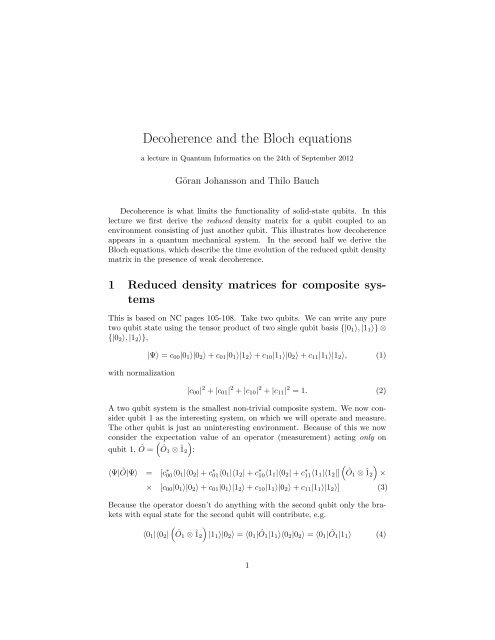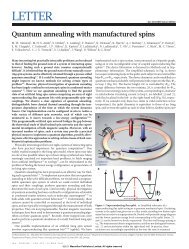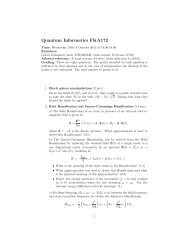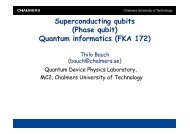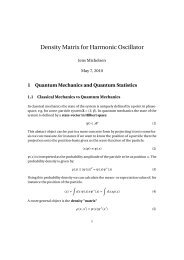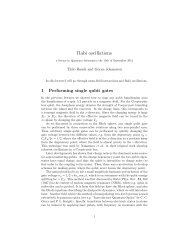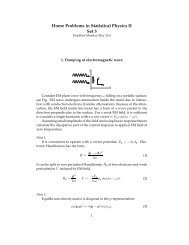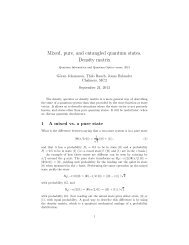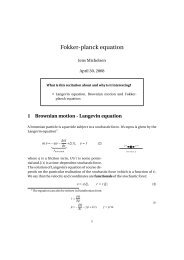Decoherence and the Bloch equations
Decoherence and the Bloch equations
Decoherence and the Bloch equations
Create successful ePaper yourself
Turn your PDF publications into a flip-book with our unique Google optimized e-Paper software.
<strong>Decoherence</strong> <strong>and</strong> <strong>the</strong> <strong>Bloch</strong> <strong>equations</strong>a lecture in Quantum Informatics on <strong>the</strong> 24th of September 2012Göran Johansson <strong>and</strong> Thilo Bauch<strong>Decoherence</strong> is what limits <strong>the</strong> functionality of solid-state qubits. In thislecture we first derive <strong>the</strong> reduced density matrix for a qubit coupled to anenvironment consisting of just ano<strong>the</strong>r qubit. This illustrates how decoherenceappears in a quantum mechanical system. In <strong>the</strong> second half we derive <strong>the</strong><strong>Bloch</strong> <strong>equations</strong>, which describe <strong>the</strong> time evolution of <strong>the</strong> reduced qubit densitymatrix in <strong>the</strong> presence of weak decoherence.1 Reduced density matrices for composite systemsThis is based on NC pages 105-108. Take two qubits. We can write any puretwo qubit state using <strong>the</strong> tensor product of two single qubit basis {|0 1 〉, |1 1 〉} ⊗{|0 2 〉, |1 2 〉},with normalization|Ψ〉 = c 00 |0 1 〉|0 2 〉 + c 01 |0 1 〉|1 2 〉 + c 10 |1 1 〉|0 2 〉 + c 11 |1 1 〉|1 2 〉, (1)|c 00 | 2 + |c 01 | 2 + |c 10 | 2 + |c 11 | 2 = 1. (2)A two qubit system is <strong>the</strong> smallest non-trivial composite system. We now considerqubit 1 as <strong>the</strong> interesting system, on which we will operate <strong>and</strong> measure.The o<strong>the</strong>r qubit is just an uninteresting environment. Because of this we nowconsider <strong>the</strong> expectation ) value of an operator (measurement) acting only onqubit 1, Ô =(Ô1 ⊗ ˆ1 2 :)〈Ψ|Ô|Ψ〉 = [c∗ 00〈0 1 |〈0 2 | + c ∗ 01〈0 1 |〈1 2 | + c ∗ 10〈1 1 |〈0 2 | + c ∗ 11〈1 1 |〈1 2 |](Ô1 ⊗ ˆ1 2 ×× [c 00 |0 1 〉|0 2 〉 + c 01 |0 1 〉|1 2 〉 + c 10 |1 1 〉|0 2 〉 + c 11 |1 1 〉|1 2 〉] (3)Because <strong>the</strong> operator doesn’t do anything with <strong>the</strong> second qubit only <strong>the</strong> braketswith equal state for <strong>the</strong> second qubit will contribute, e.g.)〈0 1 |〈0 2 |(Ô1 ⊗ ˆ1 2 |1 1 〉|0 2 〉 = 〈0 1 |Ô1|1 1 〉〈0 2 |0 2 〉 = 〈0 1 |Ô1|1 1 〉 (4)1
while)〈0 1 |〈1 2 |(Ô1 ⊗ ˆ1 2 |1 1 〉|0 2 〉 = 〈0 1 |Ô1|1 1 〉〈1 2 |0 2 〉 = 0. (5)Of <strong>the</strong> original 16 terms we are left with eight〈Ψ|Ô|Ψ〉 = [c∗ 00〈0 1 | + c ∗ 10〈1 1 |] Ô1 [c 00 |0 1 〉 + c 10 |1 1 〉] +which we should regroup+ [c ∗ 11〈1 1 | + c ∗ 01〈0 1 |] Ô1 [c 11 |1 1 〉 + c 01 |0 1 〉] , (6)〈Ψ|Ô|Ψ〉 = 〈0 1|Ô1|0 1 〉 [ |c 00 | 2 + |c 01 | 2] + 〈0 1 |Ô1|1 1 〉 [c ∗ 00c 10 + c ∗ 01c 11 ] ++ 〈1 1 |Ô1|0 1 〉 [c ∗ 10c 00 + c ∗ 11c 01 ] + 〈1 1 |Ô1|1 1 〉 [ |c 10 | 2 + |c 11 | 2] . (7)We can now construct a reduced density matrix, for <strong>the</strong> first qubit only[ ]|c00 |ρ 1 =2 + |c 01 | 2 c ∗ 10c 00 + c ∗ 11c 01c ∗ 00c 10 + c ∗ 01c 11 |c 10 | 2 + |c 11 | 2 , (8)which reproduce 〈Ψ|Ô|Ψ〉 = T r(ρ 1O 1 ). We can check that T r(ρ) = 1 <strong>and</strong> thatit is Hermitian, so it is a valid density matrix. The reduced density matrix forqubit 1, ˆρ 1 , can be also obtained from <strong>the</strong> pure two qubit density matrix |Ψ〉〈Ψ|,with |Ψ〉 given by Eq. 1, by tracing out <strong>the</strong> second qubitˆρ 1 = T r 2 (|Ψ〉〈Ψ|) =1∑〈j 2 | [|Ψ〉〈Ψ|] |j 2 〉 =j=0= 〈0 2 |Ψ〉〈Ψ|0 2 〉 + 〈1 2 |Ψ〉〈Ψ|1 2 〉 == |0 1 〉〈0 1 | [ |c 00 | 2 + |c 01 | 2] + |0 1 〉〈1 1 | [c ∗ 10c 00 + c ∗ 11c 01 ] ++ |1 1 〉〈0 1 | [c ∗ 00c 10 + c ∗ 01c 11 ] + |1 1 〉〈1 1 | [ |c 10 | 2 + |c 11 | 2] . (9)For a product state |Ψ〉 = |Ψ 1 〉|Ψ 2 〉 = [ c 1 0|0 1 〉 + c 1 1|1 1 〉 ] [ c 2 0|0 2 〉 + c 2 1|1 2 〉 ] we havec 00 = c 1 0c 2 0, c 01 = c 1 0c 2 1, c 10 = c 1 1c 2 0 <strong>and</strong> c 11 = c 1 1c 2 1. Putting this into Eq. 8,<strong>and</strong> using <strong>the</strong> normalization |c 2 0| 2 + |c 2 1| 2 = 1, gives <strong>the</strong> ordinary pure statedensity matrix for qubit 1, ρ 1 = |Ψ 1 〉〈Ψ 1 |. Instead choosing a Bell state |Ψ〉 =(|0 1 〉|0 2 〉 + |1 1 〉|1 2 〉) / √ 2, i.e. c 00 = c 11 = 1/ √ 2 <strong>and</strong> c 01 = c 10 = 0 gives[ 1]ρ 1 = 201 , (10)02which we recognize as density matrix of a mixed state with fifty/fifty spin up<strong>and</strong> down in an arbitrary direction, which maps onto <strong>the</strong> origin of <strong>the</strong> <strong>Bloch</strong>sphere r = (0, 0, 0). So even if <strong>the</strong> two qubits toge<strong>the</strong>r are in a pure state, qubitnumber 1 will behave like a mixed state.2
2 A two-level atom coupled to a <strong>the</strong>rmal bathof harmonic oscillatorsConsider <strong>the</strong> Hamiltonian of a two-level atom weakly coupled to a <strong>the</strong>rmal bathof harmonic oscillatorsH = −¯hω 02 σ z + ∑ kH c = (η z σ z + η x σ x ) ∑ k¯hω k â † kâk + H c ,g k(â k + â † k), (11)where <strong>the</strong> coupling is weak compared to <strong>the</strong> atom frequency |H c | ≪ ¯hω 0 . Thecoupling constants η z <strong>and</strong> η z determine how much <strong>the</strong> bath couples to <strong>the</strong> z<strong>and</strong> x directions of <strong>the</strong> atom. The bath of harmonic oscillators can e.g. be<strong>the</strong> electromagnetic field in a transmission line or more abstractly some bosonicdegrees of freedom we didn’t manage to decouple completely.We <strong>the</strong>n consider <strong>the</strong> combined atom-bath density matrix in <strong>the</strong> interactionpicture,ρ rf (t) = R(t)ρ(t)R(t) †using <strong>the</strong> operator (see e.g. section 4 in <strong>the</strong> Rabi lecture notes)R(t) = e −i ω 02 tσ ze i ∑ k ω kâ † kâkt ,<strong>the</strong> quick coherent dynamics is rotated away <strong>and</strong> we’ll get a differential equationfor <strong>the</strong> bath induced dynamics onlyi¯h ˙ρ rf (t) = [H c,rf (t), ρ rf (t)] , (12)where <strong>the</strong> coupling hamiltonian in <strong>the</strong> interaction picture isH c,rf (t) = R(t)H c R(t) †= ( η z σ z + η x[σ− e −iω0t + σ + e iω0t]) ∑kg k(â k e −iω kt + â † k eiω kt )≡ A(t)B(t), (13)where A(t) is an operator operating on <strong>the</strong> atom only <strong>and</strong> B(t) is a bath operator.In order to perform a perturbation expansion to <strong>the</strong> second order in <strong>the</strong>noise we first rewrite <strong>the</strong> Liouville equation on a differential-integral form[i¯h ˙ρ rf (t) = H c,rf (t), ρ rf (0) + 1 ∫ t]dt ′ [H c,rf (t ′ ), ρ rf (t ′ )] . (14)i¯hThe idea is now to trace out <strong>the</strong> bath from this equation <strong>and</strong> arrive at adifferential equation for <strong>the</strong> atom density matrix only. We <strong>the</strong>n assume that <strong>the</strong>bath density matrix is <strong>the</strong>rmal with temperature T , i.e.( )T r B â † kâk ′ = δ k,k ′n k ,03
wheren k =1exp (¯hω k /k B T ) − 1 ,is <strong>the</strong> average number of photons in <strong>the</strong> oscillator with frequency ω k accordingto <strong>the</strong> Bose distribution. Fur<strong>the</strong>rmore, we assume that <strong>the</strong> bath density matrixdoes not change during <strong>the</strong> system dynamics, mainly because <strong>the</strong> bath is large<strong>and</strong> <strong>the</strong> atom is small. Also assuming that <strong>the</strong> atom <strong>and</strong> bath are in a productstate before <strong>the</strong> coupling is switched on at t = 0, <strong>the</strong>re will be no contributionto <strong>the</strong> dynamics from <strong>the</strong> first order in H c,rf sinceleaving <strong>the</strong> second order contributionT r B {H c,rf (t)} = 0,˙ρ rf (t) = − 1 ∫ t¯h 2 dt ′ (H c,rf (t)H c,rf (t ′ )ρ rf (t ′ ) + ρ rf (t ′ )H c,rf (t ′ )H c,rf (t)−0− H c,rf (t)ρ rf (t ′ )H c,rf (t ′ ) − H c,rf (t ′ )ρ rf (t ′ )H c,rf (t)]), (15)which we <strong>the</strong>n trace over <strong>the</strong> bath, to arrive at an equation of motion for <strong>the</strong>(reduced) atom density matrix only ρ a . The bath operators <strong>the</strong>n appear in <strong>the</strong>following bath correlation functionf B (t − t ′ ) = T r B {B(t)B(t ′ )} = ∑ [gk2 (1 + n k )e −iω k(t−t ′) ] + n k e iω k(t−t ′ ),k<strong>and</strong> for <strong>the</strong> term with <strong>the</strong> opposite time-orderning we use f B (t ′ − t),˙ρ a (t) = − 1 ∫ t¯h 2 dt ′ (f B (t − t ′ )A(t)A(t ′ )ρ a (t ′ ) + f B (t ′ − t)ρ a (t ′ )A(t ′ )A(t)−0− f B (t ′ − t)A(t)ρ a (t ′ )A(t ′ ) − f B (t − t ′ )A(t ′ )ρ a (t ′ )A(t)) . (16)The bath correlation function thus depends on <strong>the</strong> couplings g k <strong>and</strong> temperature.Typically <strong>the</strong> function is close to a delta-function in time, <strong>and</strong> its widthis given by <strong>the</strong> inverse b<strong>and</strong>width of <strong>the</strong> coupling to <strong>the</strong> bath.2.1 Purely longitudinal noiseFor η x = 0 <strong>and</strong> η z = 1, <strong>the</strong> bath couples only to <strong>the</strong> time-independent A(t) = σ z ,<strong>and</strong> we have purely longitudinal noise, i.e. directed along <strong>the</strong> axis of coherentprecession. This will make <strong>the</strong> precession velocity uncertain <strong>and</strong> dephase <strong>the</strong>qubit. For <strong>the</strong> equation of motion for <strong>the</strong> reduced density matrix we have˙ρ a (t) = − 1 ∫ t¯h 2 dt ′ (f B (t − t ′ )ρ a (t ′ ) + f B (t ′ − t)ρ a (t ′ )−0− f B (t ′ − t)σ z ρ a (t ′ )σ z − f B (t − t ′ )σ z ρ a (t ′ )σ z )= − 1 ∫ t¯h 2 dt ′ (f B (t − t ′ ) + f B (t ′ − t)) (ρ a (t ′ ) − σ z ρ a (t ′ )σ z ) . (17)04
Now, using that <strong>the</strong> bath correlation function f B (t) is close to a delta-function,we can replace t ′ with t in <strong>the</strong> argument of <strong>the</strong> density matrix on <strong>the</strong> right h<strong>and</strong>side, <strong>and</strong> also extend <strong>the</strong> region of integration to infinity, to arrive at˙ρ a (t) = − 1∫ t¯h 2 (ρ a(t) − σ z ρ a (t)σ z ) dt ′ (f B (t − t ′ ) + f B (t ′ − t)) , (18)−∞which is a ordinary differential equation. From <strong>the</strong> matrix structure,[]0 ρρ(t) − σ z ρ(t)σ z = 201 (t)ρ 10 (t) 0we see that this equation describes exponential decrease of <strong>the</strong> off-diagonal elementsof <strong>the</strong> density matrix ρ 01 (t) = ρ 01 (0)e −Γ∗ 2 t , where <strong>the</strong> pure dephasingrate is given byΓ ∗ 2 = 2¯h 2 ∫ t−∞= 2¯h 2 ∫ ∞dt ′ (f B (t − t ′ ) + f B (t ′ − t)) =−∞dτ ∑ kg 2 k(1 + 2n k )e −iω kτ ≡ 2S B (0), (19)whereS B (ω) = 1¯h 2 ∫ ∞−∞dτe −iωτ ∑ kgk2 [(1 + nk )e iωkτ + n k e −iω kτ ]is (single-sided) noise spectral density of <strong>the</strong> bath, which is nothing but <strong>the</strong>Fourier transform of <strong>the</strong> bath correlation function.Remembering <strong>the</strong> mapping of <strong>the</strong> density matrix in <strong>the</strong> <strong>Bloch</strong> sphereρ = 1 + r xσ x + r y σ y + r z σ z2= 1 2[ ]1 + rz r x − ir y, (20)r x + ir y 1 − r zwe realize that <strong>the</strong> disappearance of <strong>the</strong> off-diagonal elements implies that r x<strong>and</strong> r y approaches zero, i.e. <strong>the</strong> state approaches its projection on <strong>the</strong> z-axis.Thus we get a mixed state. The phase of <strong>the</strong> atom becomes entangled with <strong>the</strong>state of <strong>the</strong> bath, <strong>and</strong> tracing out <strong>the</strong> bath we get a mixed state of <strong>the</strong> atom.2.2 Purely transversal noiseFor η z = 0 <strong>and</strong> η x = 1we have purely transversal noise, i.e. directed perpendicularto <strong>the</strong> axis of coherent precession. For simplicity we consider couplingonly to σ x . Again, using <strong>the</strong> short correlation time of <strong>the</strong> bath we arrive at <strong>the</strong>dynamics of <strong>the</strong> atom density matrix[]Γ˙ρ a (t) = ↓ ρ 11 (t) − Γ ↑ ρ 00 (t) − Γ ↑+Γ ↓2ρ 01 (t)− Γ ↑+Γ ↓2ρ 10 (t) Γ ↑ ρ a 00(t) − Γ ↓ ρ a , (21)11(t)5
where <strong>the</strong> relaxation rate<strong>and</strong> excitation rateΓ ↓ = S B (ω 0 ) ≈ 2πg 2 ω 0(1 + n ω0 )Γ ↑ = S B (−ω 0 ) ≈ 2πg 2 ω 0n ω0are given by <strong>the</strong> bath noise spectral density at <strong>the</strong> frequency of <strong>the</strong> atom transition.We see that <strong>the</strong> ration between <strong>the</strong> relaxation <strong>and</strong> excitation is given by<strong>the</strong> temperature of <strong>the</strong> bath onlyΓ ↑Γ ↓= n ω 01 + n ω0= e −¯hω0/k BT .Both off-diagonal elements also decay exponentially due to transverse noise with<strong>the</strong> rate (Γ ↑ + Γ ↓ )/2.3 <strong>Bloch</strong> <strong>equations</strong>The <strong>Bloch</strong> <strong>equations</strong> were introduced in 1946 in <strong>the</strong> context of nuclear magneticresonance (NMR). They describe <strong>the</strong> motion of a spin-1/2 on <strong>the</strong> <strong>Bloch</strong> sphere(r(t)) under <strong>the</strong> influence of control fields B(t) <strong>and</strong> dissipation described byphenomenological timescales for relaxation/mixing T 1 <strong>and</strong> dephasing T 2 :ṙ = −B × r − 1 (rz − r 0 ) 1z ẑ − (r xˆx + r y ŷ) , (22)T 1 T 2where r 0 z is <strong>the</strong> steady state projection on <strong>the</strong> z-axis. In <strong>the</strong> previous section wederived:Γ ↑Γ ↑ = S B (−ω 0 ), Γ ↓ = S B (ω 0 ), = e −¯hω0/k BTΓ ↓1= Γ ↓ + Γ ↑ , rz 0 = Γ ↓ − Γ ↑= tanh ¯hω 0T 1 Γ ↓ + Γ ↑ 2k B T ,11T2∗ = 2S B (0), = 1T 2 T2∗ + 1 , (23)2T 1where we assumed <strong>the</strong> noise arising from a source at temperature T .4 Driven <strong>Bloch</strong> <strong>equations</strong> - describing a driventransmon in a transmission lineWe start from <strong>the</strong> hamiltonian of a transmon with frequency ω 0 , driven by acoherent flux field of frequency ω dH = −¯hω 02 σ z − A cos (ω d t)σ x ,6
Then, going to a frame rotating with <strong>the</strong> drive, using <strong>the</strong> RWAH = − ∆ 2 σ z − A 2 σ x,where we introduced <strong>the</strong> detuning between <strong>the</strong> transmon <strong>and</strong> <strong>the</strong> drive ∆ =¯h(ω 0 − ω d ). By arranging <strong>the</strong> elements of <strong>the</strong> density matrix in a vector form⎡ ⎤ρ 00 (t)ρ vec (t) = ⎢ ρ 01 (t)⎥⎣ ρ 10 (t) ⎦ρ 11 (t)The Liouville equation for <strong>the</strong> time-evolution of <strong>the</strong> density matrix is a linearset of differential <strong>equations</strong>˙ρ vec (t) = L H ρ vec (t),where <strong>the</strong> Liouvillian matrix corresponding to <strong>the</strong> hamiltonian is⎡⎤0 A −A 0L H = −i⎢ A −2∆ 0 −A⎥2¯h ⎣ −A 0 2∆ A ⎦ .0 −A A 0Now, we couple <strong>the</strong> transmon to a zero temperature transmission line inducinga relaxation rate Γ ↓ <strong>and</strong> a dephasing rate Γ 2 = Γ ∗ 2 + Γ ↓ /2. Above, wefound <strong>the</strong> master equation for <strong>the</strong> undriven damped transmon[ ]Γ↓ ρ˙ρ(t) = 11 (t) −Γ 2 ρ 01 (t), (24)−Γ 2 ρ 10 (t) −Γ ↓ ρ 11 (t)<strong>and</strong> combining with <strong>the</strong> drive, <strong>the</strong> corresponding master equation for <strong>the</strong> drivendamped transmon density matrix is˙ρ vec (t) = (L H + L D ) ρ vec (t),where <strong>the</strong> damping Liouvillian matrix is⎡L D =⎢⎣⎤0 0 0 Γ ↓0 −Γ 2 0 0⎥0 0 −Γ 2 00 0 0 −Γ ↓By solving (L H + L D )ρ s = 0 (see e.g. <strong>the</strong> Ma<strong>the</strong>matica file on <strong>the</strong> homepage),we find <strong>the</strong> steady-state density-matrix⎦ .ρ 11 =ρ 01 =A 2 Γ 22A 2 Γ 2 + 2Γ ↓ (Γ 2 2 + ∆2 )AΓ ↓ (∆ + iΓ 2 )2A 2 Γ 2 + 2Γ ↓ (Γ 2 2 + ∆2 )ρ 10 = ρ ∗ 01ρ 00 = 1 − ρ 11 (25)7
The field emitted by <strong>the</strong> transmon into <strong>the</strong> transmission line is proportional toΦ out ∝ ( ρ 01 e iω dt + ρ 10 e −iω dt )remembering that <strong>the</strong> density matrix was obtained in <strong>the</strong> frame rotating with<strong>the</strong> drive.In <strong>the</strong> experiment, it is more appropriate to talk about voltage amplitudethan flux fields. In summary, we send down a voltageV in = V d sin (ω d t),<strong>and</strong> <strong>the</strong> average reflected voltage signal is <strong>the</strong> field emitted by <strong>the</strong> transmon, i.e()Γ sin (ω d t) + ∆ ↓Γ 2cos (ω d t)V r = −V d .2Γ 2 1 + ∆2 + A2Γ 2 Γ 2 ↓ Γ 2For resonant drive ∆ = 0 <strong>the</strong> reflection isΓ ↓ sin (ω d t)V r = −V d2Γ 2 1 + A2Γ ↓ Γ 2,with maximum reflectionV rV d= − Γ ↓2Γ 2=Γ ↓Γ ↓ + 2Γ ∗ 21=1 + 2Γ ∗ 2 /Γ ,↓for vanishing drive strength. The transmitted field V t is <strong>the</strong> sum of <strong>the</strong> drivefield <strong>and</strong> <strong>the</strong> field emitted by <strong>the</strong> transmon V t = V d + V r .8


